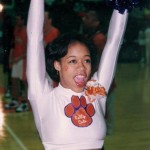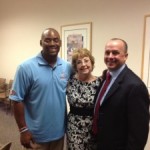Family, friends honor Keasha Rutledge Draft
July 25th, 2012 CLEMSON, SC (FOX Carolina) -
CLEMSON, SC (FOX Carolina) -
Chris Draft, a former NFL linebacker, first met LaKeasha Rutledge back in 2006 in Charlotte, NC.
“It’s crazy how things work together,” Draft said. “My cousin met a friend of hers up in New York City.”
Back in 2006, Draft was making moves on the football field with the Carolina Panthers. Before they met, Keasha Rutledge danced with the NBA Charlotte Hornets’ Honeybees and worked as an engineer.
While they dated, Draft played for several teams and in 2010 he retired. During that time, Rutledge decided to train for the Cooper River Bridge Run in Charleston.
“She really wanted to run it, so she was training,” Draft said. “She was in shape. She was strong, and because of that she just felt this little shortness of breath.”
That shortness of breath led to chest X-rays and a CT scan.
“She got the chest X-ray and the results came back and there was a mass,” Draft said. “That was right before Christmas in 2010. She got a biopsy a couple days after Christmas and it was confirmed it was lung cancer.”
At 37 years old, Rutledge, a non-smoker, was diagnosed with stage four lung cancer.
“In football we’re taught and told this could be the last game that you play,” Draft said. “And this situation was one of those that takes that so much more to that extreme.”
During those months, they made a commitment to fight. And on Nov. 27, 2011, in front of family and friends, Draft and Rutledge made another commitment to one another and got married.
“That’s my wife!” Draft said. “That’s my wife! You know? We’re going to hold on and we’re going to fight. We’re going to continue to fight.”
He said Keasha Rutledge Draft danced, smiled and lived each day and encouraged others to do the same.
A month to the day after they were married, Keasha Rutledge Draft died.
“And what helped her live was great family, great friends that remembered her of the importance of standing up and being a woman,” Draft said.
So now, instead of pads and a helmet, Draft suits up for Team Draft.
He doesn’t travel with a team of linebackers, receivers or running backs, but he still goes from city to city but with a new playbook. The new game plan is to raise money for lung cancer research in Keasha Rutledge Draft’s honor.
“Our hope is that when people think of lung cancer, they’re not going to think of a cigarette anymore,” Draft said. “But they’ll see Keasha, they’ll see her face and they’ll realize it’s people, it’s not just a disease, it’s people who need our help. I don’t want to see Keasha just as someone that passed away from lung cancer, but really someone that lived.”
Those who love her want to continue to honor her strength. Tiko Thurman, Keasha Rutledge Draft’s cousin, said she was more like a sister.
“We (were) just extremely close,” Thurman said.
Keasha Rutledge Draft grew up in Williamston and as an only child, family members said faith and family came first. She graduated from high school an academic scholar and chose to attend Clemson University. She graduated with a degree in electrical engineering.
“She was just that person when she walked into a room, things would change, people would brighten up,” Thurman said.
So, when doctors diagnosed her with stage four lung cancer, it was hard to understand.
“When Keasha got it, it really just opened my eyes to this is a deadly disease that can attack anyone, the healthiest person,” Thurman said.
Dr. Billy Bolton, a thoracic surgeon with the Greenville Hospital System didn’t treat Keasha Rutledge Draft but said her story is unfortunately a familiar one. Keasha Rutledge Draft had a form of lung cancer known as non-small cell lung cancer.
“Non-small cell lung cancer makes up the majority of lung cancer in the United States; about 75 to 85 percent of all patients,” Bolton said.” So what happens is there’s a mutation in that cell of the lung and then it continues to grow more rapidly than the other cells in that lung.”
Bolton said often times the diagnosis can be linked to two factors.
“Those two factors – secondhand smoke and radon gas, probably account for the majority of them,” Bolton said.
But he said progress is being made with research and new medicines.
“I think it would mean a whole lot to be able to see your mom and dad for four or five more years or however long it might be,” Bolton said.
One of Keasha Rutledge Draft’s closest friends, Jessie Hood, said her friend had a way of making others feel special.
“She would never ask, I never heard her say why me? She just accepted that this is what God had for her and she was going to fight,” Hood said.
They met at Clemson University and became sorority sisters.
“Her life was very special. She was a special person, she was a beautiful person, she had such capacity to love. Her heart was so big. She was an academic scholar, but she was the life of the party. She was a dancer, but she was an engineer too and she just lived each day,” Hood said.
She said her friend would light up the floor when she danced as a rally cat at Clemson, or when she shared intimate moments with friends and family.
“Her relationship with her mother was very special. Not only did they have a mother-daughter relationship, but they were really best friends too,” Hood said.
So in her honor, the Keasha Rutledge Draft Memorial Scholarship is set up for Clemson students.
“Not only are we helping future Clemson undergraduate students, we’re also helping the university,” Hood said.
And Thurman said he always knew his cousin would do big things, and though it’s tough without her, he said he’s learned a lot about life by witnessing the way she lived.
“Make sure that we make everyday a positive day. Make sure we find great things in everyday and just live life like God intended us to do. He said he wants us to live life and live it more abundantly,” Thurman said.
If you would like to be a part of Team Draft, you can donate to the Keasha Rutledge Draft Memorial Scholarship fund. All donations are tax deductible and benefit the Clemson fund.
Family and friends honor Keasha Rutledge Draft, who died after battling stage four lung cancer.




.jpg)

